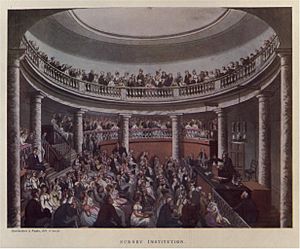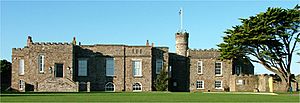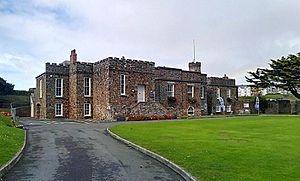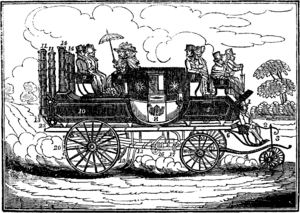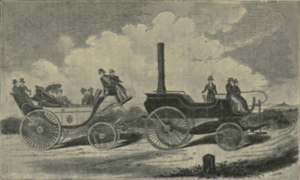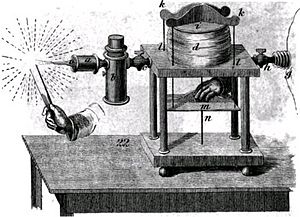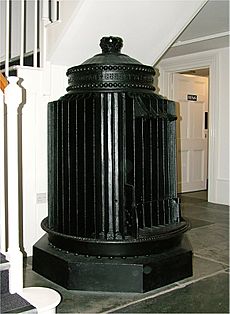Goldsworthy Gurney facts for kids
Quick facts for kids
Sir Goldsworthy Gurney
|
|
|---|---|

Goldsworthy Gurney in earlier life.
|
|
| Born | 14 February 1793 |
| Died | 28 February 1875 (aged 82) Reeds, Poughill, Cornwall
|
| Occupation | Surgeon, chemist, lecturer, consultant, architect, builder, gentleman scientist, inventor |
Sir Goldsworthy Gurney (born February 14, 1793 – died February 28, 1875) was a clever English inventor and scientist. He was a surgeon, a chemist, and a builder. He is known as a "gentleman scientist" from the Victorian era. This means he was a wealthy person who studied science and invented things as a hobby, not just for work.
Gurney created many important things. He made a special blowpipe that used oxygen and hydrogen to make a very hot flame. He used this idea to invent the Bude-Light, a super bright lamp. He also built some of the first steam-powered vehicles for roads. He even claimed to invent the blastpipe, which was very important for making steam engines powerful. The blastpipe helped steam locomotives and other coal-fired machines work much better.
His steam vehicle business faced problems. This caused a lot of debate at the time. His daughter, Anna Jane Gurney, worked hard to make sure people knew her father invented the blastpipe.
Contents
Goldsworthy Gurney's Early Life and Studies
Goldsworthy Gurney was born in St Merryn, Cornwall, England, on February 14, 1793. His unusual first name came from his grandmother's family. He went to school in Truro, where he loved science. He even met Richard Trevithick and saw his "Puffing Devil," an early steam road carriage.
After school, Gurney studied medicine. He became a surgeon in Wadebridge in 1813. He married Elizabeth Symons in 1814. Their daughter, Anna Jane, was born in 1815. While working as a surgeon, Gurney also became very interested in chemistry and machines. He was also a talented piano player and even built his own piano!
In 1820, Gurney and his family moved to London. He wanted to find more opportunities there. He continued his work as a surgeon. He also learned more about science. In 1822, he became a lecturer at the Surrey Institution. He gave talks about chemistry and how steam power could be used for road vehicles. In 1823, he won a medal for inventing an oxy-hydrogen blowpipe.
Gurney's Amazing Steam Carriages
Around 1825, Gurney started building steam-powered road vehicles. He opened a workshop in London. He got a patent for his invention. This patent was for a machine that could move carriages on roads or railways without horses. It could carry people and goods quickly.
Gurney also developed the blastpipe. This invention used steam to make air flow faster through a steam engine's chimney. This made the fire burn hotter and the engine much more powerful.
In 1826, he bought a factory and moved his family there. He worked to make his steam carriages better. His carriages were very good technically. However, he struggled to sell them. By 1832, he ran out of money. He had to sell his business. He lost a lot of his own money and money from investors. This failure caused a lot of arguments and discussions at the time.
In 1830, Gurney rented land in Bude, Cornwall. He built a new house there called "The Castle." This house was special because it had a new type of concrete foundation. The original house is still there today. It has been made bigger over the years.
At The Castle, Gurney recovered from his business problems. He focused on new inventions. He improved lighting by forcing oxygen into a flame to make it brighter. This led to his famous Bude-Light. He also used his blastpipe idea to help ventilate mines and put out underground fires.
Gurney's wife, Elizabeth, died in 1837. He moved with his daughter, Anna Jane, to a smaller house near Bude. Anna Jane was always with him. In 1844, he bought land and built another house. He also became a consultant. He used his inventions to solve problems for others. From 1852, he worked on ventilating the new Houses of Parliament in London. He had already successfully lit Parliament and Trafalgar Square.

In 1854, he was named 'Inspector of Ventilation' for Parliament. Gurney married a second time in 1854. His new wife, Jane Betty, was much younger. This marriage did not last.
Gurney continued to work on many projects. He invented the Gurney Stove for heating buildings. He also worked on electrical conduction. In 1863, Queen Victoria made him a knight. This means he was given the title "Sir." Later that year, he had a stroke. He sold his estate and moved back to Cornwall. He lived with his daughter Anna Jane until he passed away on February 28, 1875. He is buried in Launcells parish church.
Gurney's Steam Carriage Details
Between 1825 and 1829, Gurney designed and built several steam-powered road vehicles. He wanted to start a steam transport business. His vehicles were built in his factory near Regent's Park. He tested them around the park and on trips to nearby towns. They could go up to 20 miles per hour (32 km/h).
One of his vehicles made a long journey in July 1829. It traveled from London to Bath and back. The average speed for the return trip was 14 miles per hour. This included stops for fuel and water. During this trip, some people in Melksham attacked the vehicle. They threw stones because they were afraid of the new technology. The vehicle needed guards to reach Bath safely.
Gurney's steam carriage business did not succeed. People were worried about riding on a machine with a dangerous steam boiler. To fix this, Gurney designed a new vehicle called the Gurney steam drag. This was a passenger carriage pulled by a separate engine.
Two of these were sent to Glasgow around 1830. One was damaged during shipping. It was later used at a military barracks. The boiler exploded, hurting two people. This accident made the public even more afraid of steam carriages.
A regular service started between Cheltenham and Gloucester. It used three of Gurney's carriages. However, this service also failed. Horse-coach owners and local officials saw steam carriages as a threat. They worked to stop them.
In 1831, Parliament passed laws that charged very high tolls for steam carriages. A steam carriage had to pay £2 for a journey. A horse-drawn carriage paid only 2 shillings (which was much less). This made it too expensive to run steam carriages. Also, some roads were covered with deep gravel. This made it impossible for the steam carriages to drive.
Because of these problems, Gurney went bankrupt. He lost a huge amount of money. A special committee in Parliament looked into Gurney's case. They agreed that his steam carriages were safe, fast, and cheap. They also said the high tolls were unfair. The committee suggested that Gurney should be paid for his losses. They also said his patent should be extended. However, the House of Lords rejected this idea.
Other Important Inventions
One of Gurney's key inventions was the oxy-hydrogen blowpipe. This tool created a very hot flame by burning oxygen and hydrogen together. This blowpipe was the basis for "limelight," a bright light used in theaters. Gurney was the first to use it this way.
Gurney also worked on the steam-jet or blastpipe. This invention made air flow faster through pipes. He used it to improve ventilation in mines and sewers. This helped get rid of bad air and prevent diseases like cholera. He also used it to put out mine fires. For example, he put out a large mine fire in Scotland that had been burning for over 30 years! He used his steam-jet to pump special gases into the mine to stop the fire.
He also improved theater lighting with his Bude-Light. This light used a normal oil lamp flame. But by adding oxygen directly to the flame, he made it much brighter and whiter. He used a system of prisms and lenses to spread the light. Bude-Lights were installed in the House of Commons. They lit the House for sixty years before electricity arrived. You can still see replicas of Bude-Lights in Trafalgar Square today.
Gurney also worked on lighthouse lamps. He improved the light source and used special lenses. He also made lighthouses flash in unique patterns. This helped sailors identify which lighthouse they were seeing.
Another invention was the Gurney Stove, patented in 1856. This stove had special outside ribs. These ribs increased the surface area, making the stove better at heating rooms. Many of these stoves are still used today in large cathedrals like Ely and Durham.
After his success with mine ventilation, Gurney was asked to improve the lighting, heating, and ventilation of the new Houses of Parliament in 1852. He was good at moving air around the buildings. However, he could not get rid of the terrible smell from the Thames!
Gurney worked on many other projects. He had ideas and patents for better steam engine designs, electric telegraphy, and even musical instruments.
Anna Jane Gurney: Her Father's Champion
Gurney's daughter, Anna Jane, worked very hard to promote her father's inventions. She wanted everyone to know about his important contributions. The words on his gravestone say:
To his inventive genius the world is indebted for the high speed of the locomotive, without which railways could not have succeeded and would never have been made.
Anna Jane often added notes to books. In her copy of the Dictionary of National Biography, she changed every mention of "the blowpipe" to "his blowpipe."
In 1880, she gave £500 to honor her father's "Steam Jet." She even got the children of the Prince of Wales to present the money at a ceremony. Anna Jane's donation was "In memory of her father Sir Goldsworthy Gurney, inventor of the steam-jet." She believed his invention helped spread good things and God's word around the world.
In 1889, she gave a chiming clock to a church in Bude. The clock was inscribed with words about her father's inventions. It said his work in steam and electricity made transport so fast that all of England needed to keep the same time.
Anna Jane also had a stained glass window made in her father's honor. It was in a church in Westminster. Part of the inscription on the window said:
He originated the Electric Telegraph, High Speed Locomotion and Flashing Light Signalling. He invented the Steam Jet and the Oxy-Hydrogen Blowpipe.
See also
- Timeline of hydrogen technologies


